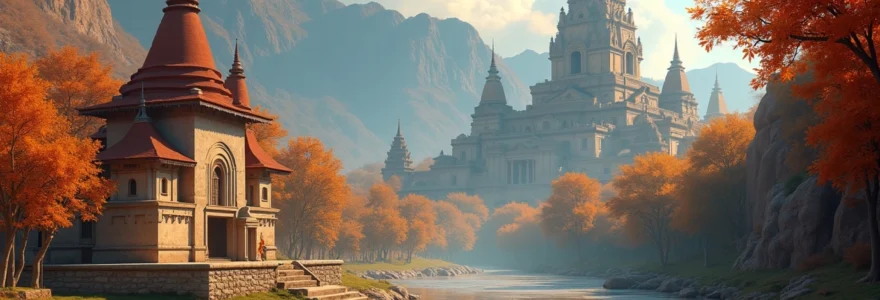Embarking on a journey to explore the world’s rich cultural tapestry can be an exhilarating and transformative experience. From ancient wonders that have withstood the test of time to vibrant festivals that celebrate the human spirit, our planet offers a treasure trove of cultural marvels waiting to be discovered. Whether you’re a history enthusiast, an art lover, or simply curious about diverse traditions, there’s an abundance of destinations that promise to leave an indelible mark on your memory.
These cultural experiences offer more than just sightseeing; they provide a window into the soul of civilisations, both past and present. They challenge our perspectives, broaden our horizons, and connect us with the shared heritage of humanity. As you plan your next adventure, consider these remarkable places and events that showcase the very best of human creativity, resilience, and diversity.
UNESCO world heritage sites: pinnacles of cultural significance
UNESCO World Heritage Sites represent the crème de la crème of cultural and natural wonders. These locations are recognised for their outstanding universal value and are protected to ensure their preservation for future generations. Among these esteemed sites, a few stand out as must-visit destinations for cultural enthusiasts.
Angkor wat: cambodia’s architectural marvel
Nestled in the heart of Cambodia, Angkor Wat is a breathtaking testament to the ingenuity of the Khmer Empire. This sprawling temple complex, built in the 12th century, is the largest religious monument in the world. Its intricate bas-reliefs, towering spires, and vast moat offer visitors a glimpse into the grandeur of ancient Khmer architecture and spirituality.
As you wander through the labyrinthine corridors and courtyards, you’ll be struck by the sheer scale and detail of the carvings that adorn every surface. The iconic silhouette of Angkor Wat at sunrise is a sight that will stay with you long after your visit. To fully appreciate the complexity of this architectural wonder, consider hiring a knowledgeable guide who can unravel the stories etched in stone.
Machu picchu: incan citadel in the andes
Perched high in the Peruvian Andes, Machu Picchu is a mystical city that captures the imagination of travellers worldwide. This 15th-century Incan stronghold was hidden from the world for centuries, only to be rediscovered in 1911. Today, it stands as a testament to the advanced engineering and architectural skills of the Inca civilisation.
The site’s dramatic setting, surrounded by misty mountain peaks, adds to its otherworldly allure. As you explore the terraced fields, temples, and dwellings, you’ll marvel at how seamlessly the structures blend with the natural landscape. For an unforgettable experience, time your visit to coincide with the winter solstice, when the sun aligns perfectly with the Temple of the Sun.
Petra: jordan’s Rose-Red city
Carved into the red rock face of southern Jordan, Petra is an archaeological masterpiece that seems to defy the laws of time and gravity. This ancient Nabataean city, with its iconic Treasury building, was a crucial junction for silk and spice trade routes connecting China, India, and Arabia with Egypt, Greece, and Rome.
As you walk through the narrow Siq canyon, the anticipation builds until you’re suddenly face-to-face with the awe-inspiring facade of the Treasury. But Petra is more than just this famous structure; it’s a vast city with amphitheatres, royal tombs, and a monastery perched high on a cliff. To truly appreciate Petra’s magic, visit at night when the Treasury is illuminated by thousands of candles, creating an ethereal atmosphere.
Immersive cultural festivals and celebrations
Cultural festivals offer a vibrant and dynamic way to experience the traditions, music, and spirit of a community. These events provide unparalleled opportunities to engage with local customs and create lasting memories.
Carnival in rio de janeiro: samba and spectacle
Rio de Janeiro’s Carnival is the epitome of jubilant celebration, drawing millions of revellers from around the globe. This explosive festival, held before Lent each year, transforms the city into a kaleidoscope of colour, music, and dance. The highlight of Carnival is the Samba Parade, where competing samba schools showcase their elaborate costumes and floats in a dazzling display of creativity and passion.
Beyond the official parade, street parties known as blocos erupt throughout the city, allowing visitors to dance alongside locals and immerse themselves in the infectious energy of the festivities. To fully experience Carnival, learn a few samba steps before you go and don’t be shy about joining in the revelry.
Holi festival: india’s vibrant colour celebration
Holi, the Festival of Colours, is a joyous Hindu celebration that welcomes spring with an explosion of vibrant hues. Participants douse each other with coloured powder and water, creating a mesmerising spectacle of rainbow-hued revellers. While Holi is celebrated throughout India, experiencing it in cities like Mathura or Vrindavan, birthplaces of Lord Krishna, adds a spiritual dimension to the festivities.
The festival is a time of forgiveness, renewal, and community bonding. As you participate in the playful colour throwing, you’ll find social barriers melting away, replaced by laughter and camaraderie. Remember to wear clothes you don’t mind getting stained, and protect your skin and hair with oil to make the colours easier to remove later.
Oktoberfest: bavaria’s historic beer festival
Oktoberfest in Munich is more than just a beer festival; it’s a celebration of Bavarian culture and traditions that dates back to 1810. For two weeks, the Theresienwiese grounds are transformed into a bustling fairground filled with massive beer tents, traditional food stalls, and carnival rides.
Inside the tents, revellers don traditional dirndls and lederhosen , raising steins of locally brewed beer to the sound of oompah bands. The atmosphere is one of jovial camaraderie, with long tables encouraging socialisation among strangers who quickly become friends. To fully immerse yourself in the Oktoberfest experience, learn a few German drinking songs and toast with a hearty “Prost!”
Day of the dead: mexico’s spiritual tradition
Día de los Muertos, or Day of the Dead, is a poignant and visually stunning Mexican holiday that honours deceased loved ones. Far from being mournful, this celebration is a joyous affirmation of life and the continuity of family bonds. Elaborate altars ( ofrendas ) are set up in homes and cemeteries, adorned with marigolds, sugar skulls, and the favourite foods and drinks of the departed.
The streets come alive with parades featuring intricate skeleton costumes and face paint. Families gather in cemeteries for picnics, sharing stories and memories of their ancestors. To truly appreciate the depth of this tradition, visit a local cemetery on the night of November 1st, where you’ll witness the touching sight of families keeping vigil by candlelight.
Ancient historical sites and archaeological wonders
Exploring ancient historical sites offers a tangible connection to our shared human history. These archaeological wonders provide insight into the lives, beliefs, and achievements of civilisations long past.
The acropolis: athens’ iconic citadel
Perched atop a rocky outcrop overlooking Athens, the Acropolis stands as a symbol of Classical Greece and the birthplace of democracy. The crowning jewel of this ancient citadel is the Parthenon, a temple dedicated to the goddess Athena that has endured for over two millennia.
As you ascend the marble steps worn smooth by countless pilgrims and tourists, you’ll be transported back to the Golden Age of Athens. The precision of the Doric columns and the remnants of intricate friezes speak to the advanced artistic and architectural skills of the ancient Greeks. Visit early in the morning or at sunset to avoid the crowds and witness the Acropolis bathed in golden light, a truly magical sight.
Pompeii: preserved roman city in italy
The ancient Roman city of Pompeii, frozen in time by the eruption of Mount Vesuvius in 79 AD, offers an unparalleled glimpse into daily life in the Roman Empire. As you walk along the stone streets, you’ll see remarkably preserved homes, shops, bathhouses, and even graffiti that could have been scrawled yesterday.
The tragedy that befell Pompeii has paradoxically resulted in one of the most comprehensive archaeological sites in the world. From the Forum to the House of the Faun , each structure tells a story of a thriving city suddenly halted in its tracks. To fully appreciate the context of Pompeii, combine your visit with a trip to the Naples National Archaeological Museum, which houses many of the artefacts recovered from the site.
Chichen itza: mayan ruins in yucatan
The ancient Mayan city of Chichen Itza in Mexico’s Yucatan Peninsula is a testament to the mathematical and astronomical prowess of the Maya civilisation. The centrepiece of the site is the iconic El Castillo pyramid, also known as the Temple of Kukulcan, which serves as a monumental calendar.
During the spring and autumn equinoxes, the setting sun creates a shadow play on the pyramid’s steps, giving the illusion of a serpent descending the structure. This phenomenal display of ancient engineering and celestial knowledge draws thousands of spectators. Beyond El Castillo, explore the Great Ball Court and the Sacred Cenote to gain a fuller understanding of Mayan rituals and daily life.
Artistic and architectural marvels
The world’s greatest artistic and architectural achievements offer profound insights into human creativity and cultural expression. These masterpieces continue to inspire and awe visitors from around the globe.
The louvre: paris’ treasure trove of art
The Louvre Museum in Paris is not just the world’s largest art museum; it’s a journey through the history of human artistic expression. Housing over 380,000 objects and displaying 35,000 works of art, including the enigmatic Mona Lisa and the iconic Venus de Milo, the Louvre can be overwhelming in its scope.
The building itself, a former royal palace, is a masterpiece of French Renaissance architecture. As you wander through its halls, you’ll encounter artistic treasures from ancient civilisations to the mid-19th century. To make the most of your visit, consider a themed tour focusing on specific periods or styles that interest you most, or use the museum’s excellent multimedia guide for deeper insights.
Sagrada familia: gaudi’s masterpiece in barcelona
Antoni Gaudí’s unfinished masterpiece, the Sagrada Familia, is a testament to the architect’s unique vision and Barcelona’s modernist heritage. This extraordinary basilica, with its organic forms and intricate symbolism, has been under construction for over 140 years and is slated for completion in 2026.
The exterior facades tell the story of Christ’s life, while the interior is a forest of tree-like columns bathed in colourful light from the stained-glass windows. To fully appreciate Gaudí’s genius, book a tour that includes access to the towers, offering panoramic views of Barcelona and a closer look at the intricate stonework.
Sistine chapel: michelangelo’s frescoes in vatican city
The Sistine Chapel in Vatican City is home to some of the world’s most recognised and revered works of art. Michelangelo’s frescoes on the ceiling and altar wall, including the famous Creation of Adam, represent the pinnacle of Renaissance art and continue to inspire awe in visitors centuries later.
The chapel’s significance extends beyond its artistic value; it’s also where the College of Cardinals gathers to elect a new pope. As you crane your neck to take in the magnificent ceiling, you’ll be struck by the scale and detail of Michelangelo’s achievement. To avoid the crowds and have a more contemplative experience, consider booking an early morning or after-hours tour of the Vatican Museums, which includes the Sistine Chapel.
Indigenous cultural experiences
Engaging with indigenous cultures offers a unique perspective on traditional ways of life and deep connections to the land. These experiences provide valuable insights into alternative worldviews and sustainable practices.
Maori villages: new zealand’s living heritage
Visiting a Maori village in New Zealand offers a profound connection to the country’s indigenous culture. Many Maori communities welcome visitors to experience their traditions, from powerful haka performances to intricate wood carving demonstrations. In Rotorua, you can participate in a hangi , a traditional feast cooked in an earth oven, and learn about Maori customs and legends.
These cultural exchanges go beyond mere tourist attractions; they’re opportunities for genuine cultural dialogue and understanding. Approach your visit with respect and an open mind, and you’ll gain valuable insights into Maori spirituality, community values, and their deep connection to the land.
Aboriginal dreamtime: australia’s ancient storytelling
Australia’s Aboriginal culture, one of the oldest continuous cultures in the world, offers visitors a unique perspective on the land and its spiritual significance. Dreamtime stories, passed down through generations, explain the creation of the landscape and provide moral and practical guidance for living.
In places like Uluru-Kata Tjuta National Park, you can join guided walks led by Aboriginal elders who share their knowledge of bush tucker (native foods), traditional medicine, and the sacred sites that dot the landscape. Participating in a dot painting workshop or listening to didgeridoo performances can provide deeper insights into Aboriginal art and music.
Sami culture: arctic indigenous traditions
The Sami people of northern Scandinavia have inhabited the Arctic regions for thousands of years, developing a unique culture closely tied to reindeer herding and the harsh northern environment. Visiting a Sami community in Norway, Sweden, or Finland offers a glimpse into this resilient culture and their traditional way of life.
You might have the opportunity to stay in a lavvu (traditional tent), learn about reindeer husbandry, or listen to joik , the traditional Sami form of song. Timing your visit to coincide with one of the Sami festivals, such as the winter market in Jokkmokk, Sweden, can provide an even richer cultural experience.
Culinary tourism and gastronomic journeys
Exploring a culture through its cuisine can be one of the most rewarding and delicious ways to travel. Culinary tourism offers insights into local traditions, agricultural practices, and social customs.
Tokyo’s tsukiji fish market: sushi at its source
While the inner market of Tsukiji has moved to Toyosu, the outer market remains a bustling hub of Japanese culinary culture. Here, you can witness the incredible variety of seafood that forms the backbone of Japanese cuisine. From watching skilled fishmongers fillet enormous tuna to sampling the freshest sushi for breakfast, Tsukiji offers an unparalleled gastronomic experience.
The market is also an excellent place to purchase high-quality kitchen knives and other cooking utensils. For the best experience, arrive early to soak in the lively atmosphere and enjoy a sushi breakfast at one of the small restaurants surrounding the market.
Tuscan vineyards: italian wine culture
The rolling hills of Tuscany, dotted with cypress trees and medieval villages, are home to some of Italy’s most renowned wines. A journey through Tuscan vineyards is not just about tasting exquisite Chianti or Brunello; it’s an imm
ersion into Italian wine culture. Many wineries offer tours and tastings, allowing visitors to learn about the winemaking process, from grape cultivation to fermentation and aging.
As you sample different vintages, you’ll also learn about the importance of terroir – the unique combination of soil, climate, and topography that gives each wine its distinct character. For a truly immersive experience, consider staying at an agriturismo, a working farm that offers accommodation, allowing you to participate in the grape harvest or olive picking, depending on the season.
Bangkok street food: thai culinary exploration
Bangkok’s vibrant street food scene is a feast for the senses and a window into Thai culinary culture. From sizzling satay skewers to fragrant bowls of tom yum soup, the city’s streets are lined with food carts and small eateries offering an incredible variety of dishes.
Exploring Bangkok’s street food is not just about satisfying your hunger; it’s about understanding the complex flavors and techniques that make Thai cuisine so beloved worldwide. Many vendors specialize in a single dish, perfecting it over generations. For a guided introduction to Bangkok’s street food, consider joining a night food tour that combines tasting with cultural insights and food history.
As you sample dishes from different regions of Thailand, you’ll gain an appreciation for the balance of sweet, sour, salty, and spicy flavors that characterize Thai cuisine. Don’t be afraid to try unfamiliar dishes – some of the best culinary discoveries happen when you step out of your comfort zone.
Whether you’re exploring ancient ruins, participating in vibrant festivals, or savoring local cuisines, these cultural experiences offer a deeper understanding of the world’s diverse heritage. They challenge our perspectives, broaden our horizons, and create memories that last a lifetime. As you plan your next adventure, consider incorporating some of these remarkable cultural encounters to enrich your travel experience and gain a new appreciation for the tapestry of human civilization.


